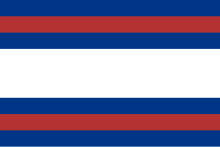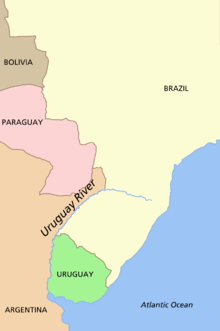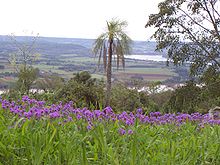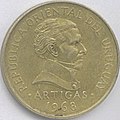José Gervasio Artigas
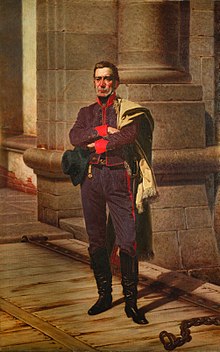
José Gervasio Artigas (born June 19, 1764 in Montevideo , Viceroyalty of the Río de la Plata , † September 23, 1850 in Ibiray near Asunción , Paraguay ) was a Uruguayan general and politician . He is a national hero in Uruguay and is also known as the "father of the independence of Uruguay". The titles "Jefe de los Orientales" (Leader of the Eastern - an alternative name for the inhabitants of today's Uruguay, which refers to the location east of the Río Uruguay ) and "Protector de los Pueblos Libres" (Protector of the Free Peoples) he received because of his services to the revolution in the viceroyalty of the Río de la Plata against colonial rule and the formation of the departments based on the model of the US states.
From childhood to military service
Artigas was born in Montevideo as the son of police officer Martin José Artigas and his wife Antonia Arnal Rodríguez. The Artigas family comes from Puebla de Albortón (Province of Saragossa, Region of Aragon, in northern Spain). His grandfather was one of the first Montevideo settlers. José Gervasio received elementary school education in the Franciscan monastery of St. Bernardino, in whose college he probably entered in 1774. At the age of twelve he went to the family's own lands in the Banda Oriental (later synonymous with Uruguay). There he got in close contact with the gauchos and learned to ride and handle weapons. He also participated in illegal activities such as smuggling on the border with Brazil and cattle theft. He lived in the north of the country with his wife and son on the Río Negro in close contact with the indigenous people, the Charrúas . At the age of 33, he took an amnesty in 1797 and joined the Corps of Blandengues ( Cuerpo de Blandengues ), a militia of the viceroyalty of the Río de la Plata, whose task it was to protect the border with Brazil. In the corps, Artigas met an African from Montevideo, Joaquín Lenzina , who had been taken prisoner by Portugal . Artigas bought him out of slavery. Lenzina, known as "the black Ansina", accompanied him all his life as his best friend, war comrade and chronicler. At the turn of the century, Artigas, as adjutant Félix de Azaras, was also concerned with the problem of land distribution. In 1803 he was appointed Comandante general de la Campaña , the commander for the flat country. In this context, he was now involved, among other things, with the fight against smuggling.
Participation in the struggle for freedom
Artigas played a key role in founding the city of Batovy in the Misiones Orientales area . From 1806 to 1807 he participated in the Spanish resistance against the British invasion of the Rio de la Plata . For his commitment to the liberation of Montevideo and Buenos Aires , he was appointed captain of the militia and a little later as adjudant major. In another battle, Artigas was captured by the English and was supposed to be shipped to England. Due to a wound, this was refrained from. Because of Napoleon's intervention in Spanish domestic politics with the abdication of King Charles IV , Spanish power in the colonies was weakened. In the viceroyalty of the Río de la Plata, the first uprising occurred on May 25, 1809 in the city of Chuquisaca . On May 25, 1810, Viceroy Baltasar de Cisneros was deposed in Buenos Aires. It was replaced by an elected council as a result of the May Revolution . The Spanish government moved its headquarters to Montevideo. Artigas was still in Spanish service and was supposed to put down a popular uprising in the Banda Oriental. The local leaders caused him a defeat.
In 1811 the new viceroy Francisco Javier de Elío came to Montevideo; Unaware of the real balance of power, he declared war on the council in Buenos Aires on February 13, 1811. As early as August 1810, the secretary of the council, Mariano Moreno , wrote to Artigas, among others, and offered him extensive powers in the event of a desertion . Artigas responded and was sent by the council as a lieutenant colonel with 150 soldiers to the Banda Oriental to organize a popular uprising. With the " Appeal from Mercedes " on April 11, 1811, Artigas took command of the revolution in the Banda Oriental. On April 25, 1811, his brother Francisco Manuel Artigas defeated the Spanish troops in Minas , San Carlos and Maldonado . On May 18, 1811, José Artigas defeated the Spaniards at the Battle of Las Piedras and was celebrated in Montevideo as the "Primer Jefe de los Orientales". After Maroñas , the National Congress was convened in 1812. Artigas proclaimed the Provincia Oriental there. Artigas signed the armistice agreement with Viceroy Elío for the council in Buenos Aires. According to the contract, he had to withdraw his troops from the Banda Oriental and Montevideo.
Eastern exodus
Artigas went with his followers to the western bank of the Uruguay River . In Uruguayan historiography this is referred to as the " Eastern Exodus ". In January 1812, Artigas set up his new camp with 16,000 people, equipment and cattle in the province of Misiones , north of today's city of Concordia . From there he kept in contact with the leaders of Entre Ríos and Corrientes and thus created a basis for his influence on the territories in the Argentine coastal area. At the beginning of 1812 the armistice ended. The insurgents under Manuel de Sarratea , a competitor of Artigas, occupied Montevideo again. Artigas was only able to move into Montevideo after Sarratea's withdrawal.
The beginnings of federalism
MPs were elected from the Artigas camp and attended the Constituent Assembly in Buenos Aires in 1813 . They received instructions from him that stated the following: declaration of independence, civil and religious freedom, a federal political order, independent states, Buenos Aires should not be the seat of the central government. The assembly rejected his proposals because they came from a military camp and the assembly declared that it was sovereign. General José Rondeau had new MPs elected to argue against Artigas. Artigas angrily withdrew to his supporters on the Uruguay River. From there he led some campaigns in the interior of the Banda Oriental and Entre Ríos. He struck an expedition sent against him in Entre Ríos. Thereupon the Director Supremo of the United Provinces signed a decree on February 11, 1814, in which Artigas was declared a “traitor to the fatherland”. It said in Article 1: Don José Artigas is declared dishonorable, relieved of his offices, he is outlawed and an enemy of the fatherland . Article 2: He is persecuted as a traitor to the fatherland and killed in case of resistance. Article 3: All the peoples, the courts, the military commanders and the citizens of the united provinces pursue the traitor by all possible means. Any help given to him is considered high treason . Anyone who hands Artigas over alive or dead will receive a reward of six thousand pesos .
Civil War and Federal League
In 1814 the League of Free Peoples was organized and Montevideo escaped the control of the Unitarians in Buenos Aires. In the following months a civil war developed between the federalist supporters of Artigas in Corrientes, Entre Rios and Provincia Oriental against the leadership of the united provinces . Artigas got the upper hand. One province after another broke away from the Unitarian guardianship in Montevideo. Artigas set up his new camp in May 1815 in Purificación del Hervidero , near the present-day city of Salto . In fact, it became the capital of the Federal League , from which the then Federal Party of Argentina developed, which took Artigas' flag as its symbol. Artigas's force consisted of around 1,500 fighters. Most of them were Indians who came from run-down Jesuit settlements, were very undemanding and ready to fight. Artigas called on June 29, 1815 for the "Congress of Free Peoples" in Concepción. Problems of political organization, trade, relations with foreign countries, agricultural policy and relations with the other countries of the former viceroyalty were to be dealt with. At this congress the provinces of Banda Oriental, Córdoba , Corrientes , Misiones and Santa Fe declared themselves independent "of all foreign powers".
exile
The union collapsed in 1816 when the Portuguese under Carlos Federico Lecor occupied the Provincia Oriental for Brazil. The government in Buenos Aires stood idly by. Artigas defended himself militarily for four years and had to flee to Paraguay in 1820 after the battle of Tacuarembó , which was lost on January 22, 1820 . The local dictator José Gaspar Rodríguez de Francia banished him to Candelaria . After a long exile, Artigas died on September 23, 1850 in Ibiray near Asunción , without ever having re-entered Uruguay, which had become independent between 1825 and 1828.
Visions
Artigas admired the United States of America and took the American constitution as a model. He wanted to merge the provinces on the Rio de la Plata into one federal state. The government in Buenos Aires wanted a central state . She toyed with the idea of placing a monarch at the top based on the European model . All of this went against the fundamental beliefs of Artigas.
Honor
Artigas' remains were transferred to Montevideo six years after his death in 1856 and buried in the Panteón Nacional . His tombstone was inscribed Artigas: fundador de la nacionalidad oriental . Today the Artigas mausoleum is located in the heart of Montevideo on Plaza Independencia , above which an Artigas rider statue dominates the square. Artigas is revered today in Uruguay as the country's national hero. The country minted many coins with his portrait. The Artigas department bears his name, as does the department capital of the same name . Still pictures of Artigas can be found in Montevideo, Santiago de Chile , Minnesota , Newark (New Jersey) , New York and Washington, DC In many Uruguayan cities there are also places named after him. An extinct large species of rodent, the fossils of which were found in Uruguay, was named Josephoartigasia in honor of Artigas . The former main train station of Montevideos was named after him: Montevideo Estación Central General Artigas . A monument to José Gervasio Artigas was erected on the summit of Cerro Artigas .
literature
- John Street: Artigas and the Emancipation of Uruguay , Cambridge University Press 1971, ISBN 0-521-06563-1
- Manfred Kossok in Biographies on World History , VEB Deutscher Verlag der Wissenschaften, Berlin 1989, p. 49
Web links
- Biography (English)
Individual evidence
- ↑ Cronología de la República de Uruguay (desde 1516 a 1828) (Spanish), accessed on February 23, 2012
- ↑ CRONOLOGÍA DE LA BANDA ORIENTAL ( Memento of the original dated August 16, 2012 in the Internet Archive ) Info: The archive link was inserted automatically and has not yet been checked. Please check the original and archive link according to the instructions and then remove this notice. (Spanish), accessed February 23, 2012
- ↑ Artigas: fundador de la nacionalidad oriental ( page no longer available , search in web archives ) Info: The link was automatically marked as defective. Please check the link according to the instructions and then remove this notice. (Spanish), biography on the website of the Venezuelan Ministry of Foreign Affairs, accessed on February 15, 2012
- ↑ [1] (Spanish) at www.welcomeuruguay.com, accessed on February 15, 2012
| personal data | |
|---|---|
| SURNAME | Artigas, José Gervasio |
| BRIEF DESCRIPTION | Uruguayan officer and freedom fighter |
| DATE OF BIRTH | June 19, 1764 |
| PLACE OF BIRTH | Montevideo |
| DATE OF DEATH | September 23, 1850 |
| Place of death | Ibiray |


